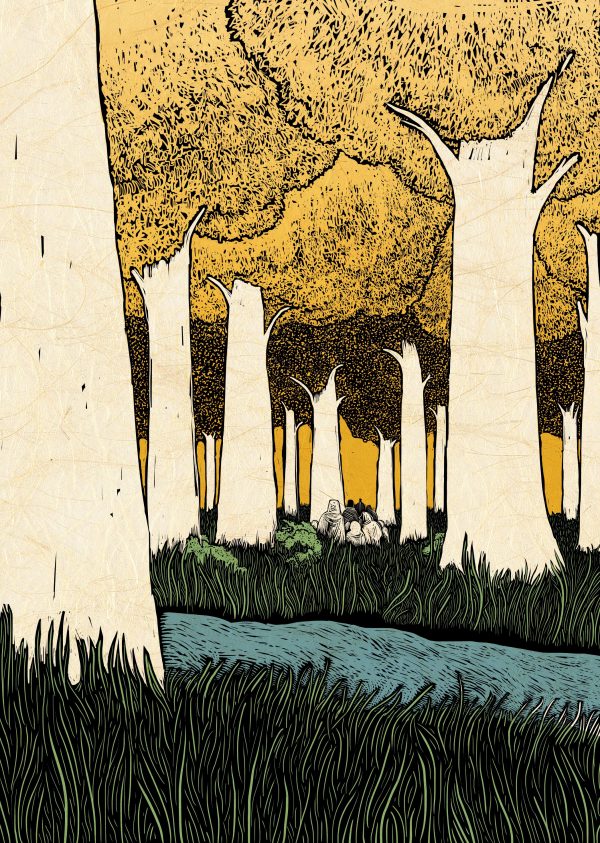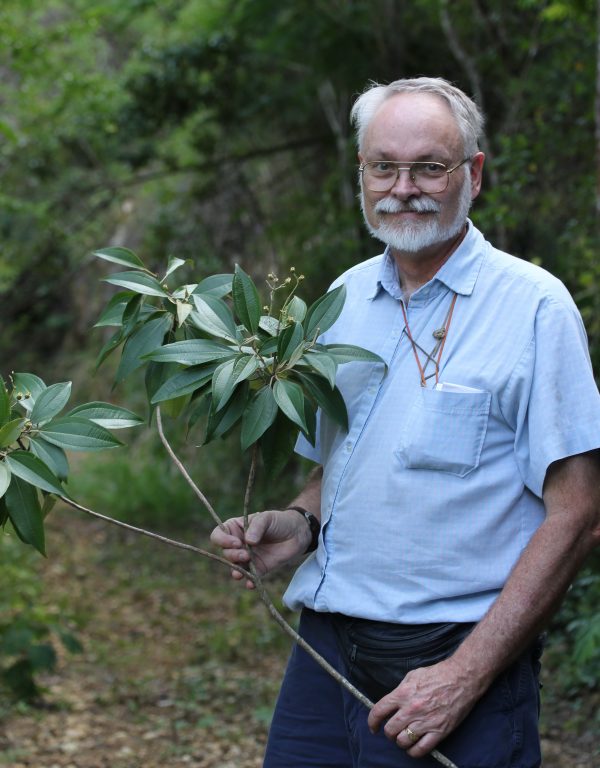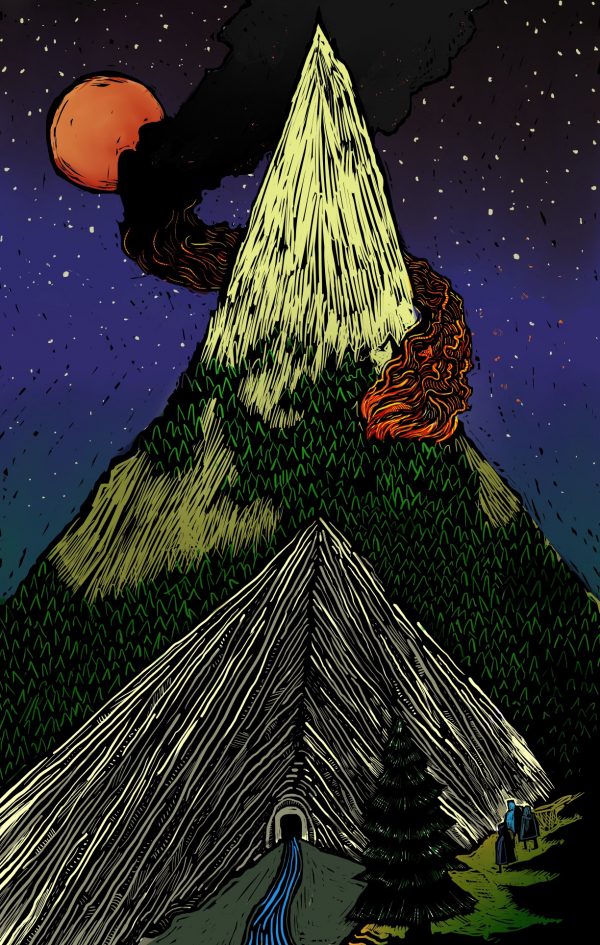
Illustration courtesy of Graham Judd
Whether they are flowering in a field, preserved in the Florida Museum of Natural History Herbarium or used to make the paper pages bound between covers in a book, botanist Walter Judd loves plants.
Not many people know the University of Florida campus quite like Judd, who takes time to stop and notice the many live oaks, southern magnolias, cabbage palms and pines as he walks to Dickinson Hall, which houses most of the Florida Museum’s collections and research activities.
Most people, instead, are what Judd calls “plant blind.”
Plant blindness is similar to the way a movie scene blurs out background settings to focus on what people find most important and compelling: the plot of the characters. This may even be an evolutionary adaptation.
“Typically plants are not a threat to us, but if you’re walking along you might notice some animal, because that could be a threat,” said Judd, UF distinguished professor emeritus of biology and courtesy curator of botany at the Florida Museum on the UF campus.
Whatever the reason, Judd wants to reverse this “blindness” by making plants more accessible to those who do not study botany or other sciences. He was inspired by J.R.R. Tolkien’s books in the fictional universe Middle-earth, which Tolkien developed in part to highlight some of the environmental issues about which he was passionate.
“Sometimes you become too used to the world around you,” Judd said. “You see it so often that you don’t really realize how special it is. Tolkien wanted people to encounter the world again, and see it as it should be seen.”
Judd’s new book “The plants of J.R.R. Tolkien: A Flora of Middle-earth” will enable fans of both fantasy and science to peel back the layers of figurative language Tolkien used in seven of his written works. It is expected to be published in fall 2016 by Oxford University Press.
The idea for the book came from his wife, Beverly Judd.
“She’s absorbed a lot of botany through osmosis, so to speak, and has read “The Hobbit” and “The Lord of the Rings,” and thought this would be a fun idea,” he said.
But as a biology professor at UF, Judd felt he was too busy to write the book. After retiring from teaching in 2013, he decided to put pen to paper for his own Tolkien-style epic journey.
Through an analysis of the plant communities that exist in Middle-earth and explanations of the language and descriptions Tolkien uses for the 141 real and fictional plants mentioned in his books, Judd hopes others will appreciate the details Tolkien included in his writings and become more conscious of the importance of the natural world.
“Everyone knows that Tolkien pays a lot of attention to detail in his writing, but not too many people know that he paid so much attention to the details of the plants, their morphology, ecology and the etymology of their names,” Judd said.
The Road to Conservation
Growing up in Britain during the period of early-20th-century industrialization, Tolkien was frustrated by the lack of respect nature received. His passion for environmentalism and conservationism are prominent in his writings, as Judd details in his book.

Photo courtesy of Gretchen Ionta
“He offers his view of conservation by telling you what the scenery is like where characters live,” Judd said. “When Tolkien describes The Shire, they are practicing sustainable agriculture with lots of their environment still in the natural state.”
In other places, like the elven forest kingdom Lothlórien and the forests that the tree-like Ents inhabit, different species practice other forms of conservation and barely alter the landscape. The elves, for example, artistically enhance the beauty of trees to display their appreciation for the natural world.
“All of the species think something different about how the natural world should be treated and how we should live with the land,” Judd said. “Tolkien never tells you which one is right, but he shows them all as being culturally appropriate.”
Even antagonists in Tolkien’s stories have characteristics similar to his idea of the real life villain—modern industrialization that damages nature. For example, the evil wizard Saruman the White is described as having “a mind of metal and wheels.”
“He doesn’t care for living things other than the uses he can put them to,” Judd said.
Judd said he is hopeful his book will help even the most “plant blind” person discover and appreciate real and fictional plants due to Tolkien’s wide following and the fact his books are easily accessible and more interesting than often-dry academic textbooks.
“People are going to read my book and learn about oaks, beeches, pines and maples, and yes you can read a textbook and find out the same things, but most people that are going to be reading Tolkien’s books are never going to be reading a botany textbook,” Judd said. “It’s important to expand the audience.”
The Voice of Nature
Judd knew his book would need illustrations of Middle-earth in addition to scientific analysis. Tolkien’s descriptions of Middle-earth are detailed and thorough. He created his own artwork for several key locations, and many book readers picture the settings made famous in Peter Jackson’s film series.
“Biology is visual,” Judd said. “You can’t imagine somebody talking about biology without showing pictures. We’re talking about living organisms that need to be described and visualized.”
Judd did not have to search for long to find a solution. His two sons, Graham and Reuben, are both artists. When he heard about the opportunity, Graham Judd was eager to work on illustrations for the books he grew up reading.
“We’ve always had a shared passion for fantasy, especially ‘Lord of the Rings,’ so we thought it was a good idea to team up and use our skills,” said Graham Judd, the book’s co-author and illustrator.
Although other artists have created pictorial versions of Tolkien’s written word, Walter Judd wanted the illustrations that accompanied his book to be different.
Flipping through a copy of the “Silmarillion,” Walter Judd pointed out issues he has with some illustrations.
“This artist uses the super-realistic style that is very popular in fantasy,” Walter Judd said, pointing to a picture of the elf Saeros being chased off a mountain. “But these are all firs, and the problem is when you read the story, Tolkien says that this forest is dominated by oaks, beeches and elms. The artist was very careful with the characters — who are doing the appropriate things in the story – but he’s not so careful about the botanical side.”

Illustration courtesy of Graham Judd
Graham Judd said this is a common issue with contemporary fantasy art, in which most artists create more focus and detail on their characters than their surroundings.
“It’s not how you’re taught in art school,” he said. “It’s hard to switch your brain to think in that way, but we wanted to put plants as the focus in the drama of the illustrations, which creates a new view and goes against the common tendencies of artists.”
Graham Judd went back to the roots of botanical illustrations to develop his illustrations of plants and scenes from the books. Drawing digitally, he created updated versions of black and white woodcut sketches.
“It’s a style that I’m very comfortable with, and it has an ancient feel to it,” Graham Judd said. “It fits the community of Middle-earth because there is not a lot of technology mentioned, and if they did have books with moveable type, this might be a way they would create illustrations.”
Each plant is drawn individually next to its description the way it would look in a guidebook for finding plants in the wild.
“A lot of people don’t know the botany well enough to realize that the trees that Tolkien talks about may be in their front yard,” Walter Judd said. “That’s why it’s helpful to know what it looks like.”
He said helping readers see the significance and value of plants in their everyday lives is what he hopes the new book accomplishes.
“After doing dozens of these illustrations, as somebody who is not as good at science, I reread those books in a new way,” Graham Judd said. “I start to actually see the plants in the story.”
There will also be illustrations of Tolkien’s fictional plants, including the mystical gold and silver mallorn-trees, based on real-life beeches. Walter Judd wants people to admire trees like this in the way Tolkien’s characters do.
“Frodo is at the edge of the forest, touches the bark of the mallorn-tree, and all of a sudden a strange sensation goes through him. He touches it and appreciates it just as a living organism,” Walter Judd said.
Learn more about the Herbarium at the Florida Museum.